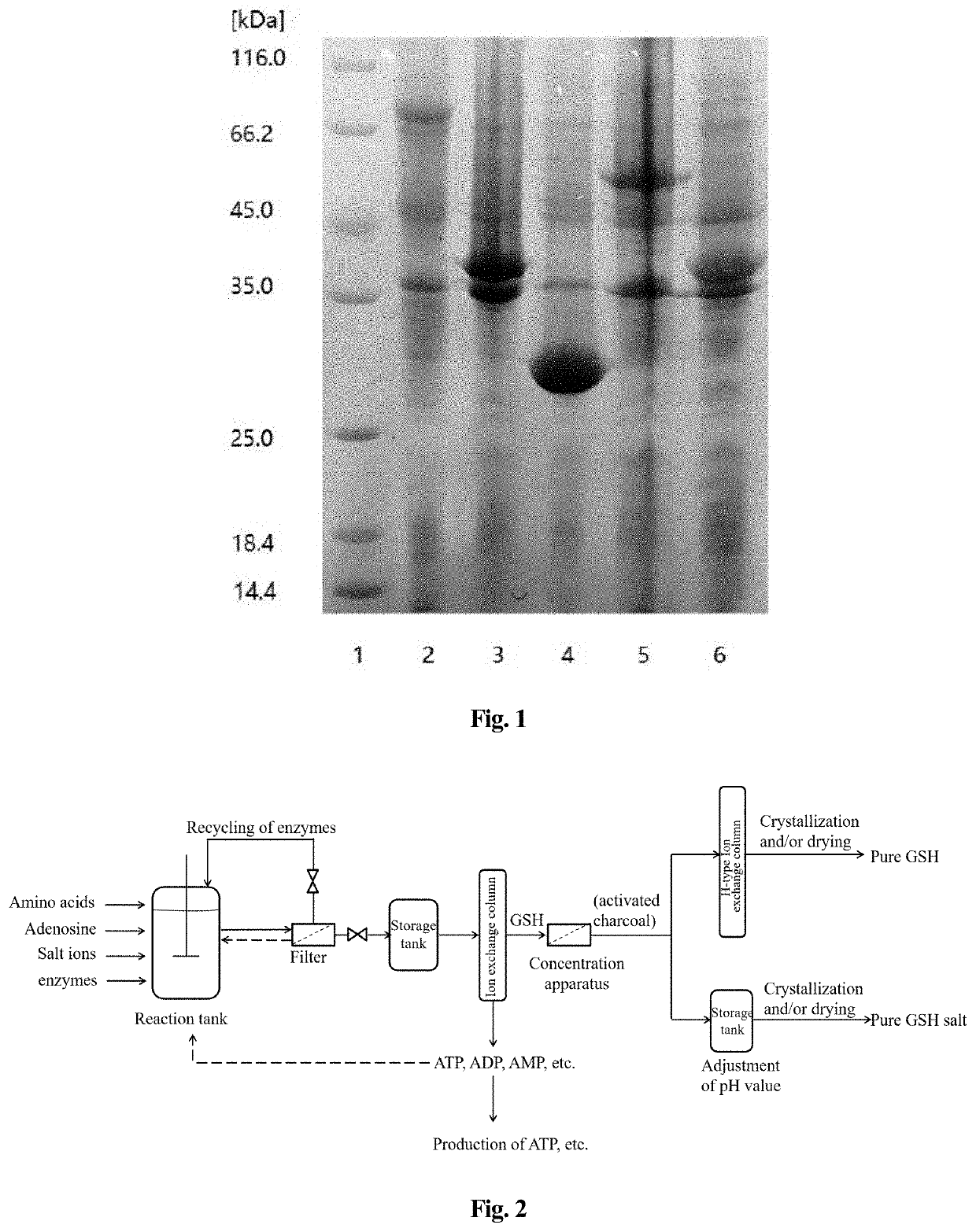Method for enzymatic preparation of glutathione
a technology of enzymatic preparation and glutathione, which is applied in the field of enzymatic preparation of glutathione, can solve the problems of difficult popularization of chemical synthesis methods, poor product purity, and high consumption of food, and achieves high conversion rate, reduces industrial production cost, and fast reaction rate
- Summary
- Abstract
- Description
- Claims
- Application Information
AI Technical Summary
Benefits of technology
Problems solved by technology
Method used
Image
Examples
example 1
Preparation of crude Enzyme
[0048]The GshF enzyme, ATP regeneration enzyme and AK enzyme in the method of the present invention are commercially available, or are enzymes that have been artificially engineered to have the same catalytic function.
[0049]The preparation process of the enzyme is as follows:
[0050]Primers were designed based on the gene sequences of each of GshF enzyme, PPK enzyme, ADK enzyme, PAP enzyme and AK enzyme, and the gene fragments were amplified by PCR and ligated to the pET22b plasmid (commercially available), respectively, and respectively transferred to E. coli BL21 (DE3) strain (commercially available) after correct sequencing.
[0051]The transformed E. coli BL21 (DE3) monoclone was inoculated into LB medium, and after incubation in the logarithmic phase, 1 mM isopropyl-β-D-thiogalactopyranoside (IPTG) was added for induction. The bacteria were harvested after 5 hours of induction, and the high expression strains were screened using sodium dodecyl sulfate-poly...
example 2
Preparation of GSH Using Free Enzyme
[0056]As shown in FIG. 2, the preparation of GSH using free enzymes includes the following steps:
[0057](1) Generation of GSH in the reaction tank:
[0058]in the reaction tank, 100 L of the reaction system was a solution containing substrate 2.5 kg of glutamic acid, 2.5 kg of cysteine and 1.5 kg of glycine, 0.3 kg of adenosine, and 2.5 kg of sodium hexametaphosphate, 0.2 kg of ammonium sulfate, 0.3 kg of sodium chloride, 0.5 kg of magnesium chloride hexahydrate, 0.1 kg of manganese chloride monohydrate and 0.5 kg of disodium hydrogen phosphate, and the solution was uniformly stirred when formulated to prevent precipitation. The pH was adjusted to 7.0, and GshF enzyme 800 U / L, PPK enzyme 500 U / L, ADK enzyme 500 U / L, PAP enzyme 200 U / L and AK enzyme 600 U / L were added to the reaction system to start the reaction, and the enzymes added were all crude enzyme solutions. The pH value was controlled to 7.0 during the reaction and the temperature was 37° C.
[...
example 3
Preparation of GSH Using Free Enzyme
[0070]As shown in FIG. 2, the preparation of GSH using free enzymes includes the following steps:
[0071](1) Generation of GSH in the reaction tank:
[0072]in the reaction tank, 100 L of the reaction system was a solution containing substrate 2.0 kg of glutamic acid, 2.0 kg of cysteine hydrochloride and 2.0 kg of glycine, 0.2 kg of adenosine, and 1.5 kg of sodium hexametaphosphate, 0.2 kg of ammonium chloride, 0.2 kg of potassium chloride, 0.8 kg of magnesium chloride hexahydrate, and 0.3 kg of Tris, and the solution was uniformly stirred when formulated to prevent precipitation. The pH was adjusted to 7.4, and GshF enzyme 1000 U / L, PPK enzyme 300 U / L, ADK enzyme 300 U / L, and AK enzyme 500 U / L were added to the reaction system to start the reaction, and the enzymes added were all crude enzyme solutions. The pH value was controlled to 7.4 during the reaction and the temperature was 40° C.
[0073]After 6 hours of reaction, the production amount of glutath...
PUM
| Property | Measurement | Unit |
|---|---|---|
| Temperature | aaaaa | aaaaa |
| Temperature | aaaaa | aaaaa |
| Fraction | aaaaa | aaaaa |
Abstract
Description
Claims
Application Information
 Login to View More
Login to View More - R&D
- Intellectual Property
- Life Sciences
- Materials
- Tech Scout
- Unparalleled Data Quality
- Higher Quality Content
- 60% Fewer Hallucinations
Browse by: Latest US Patents, China's latest patents, Technical Efficacy Thesaurus, Application Domain, Technology Topic, Popular Technical Reports.
© 2025 PatSnap. All rights reserved.Legal|Privacy policy|Modern Slavery Act Transparency Statement|Sitemap|About US| Contact US: help@patsnap.com


